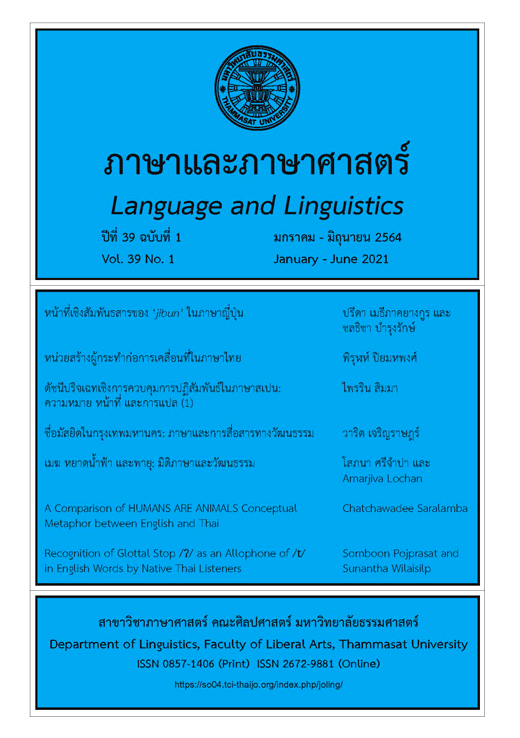The Discourse Functions of 'jibun' in Japanese
Main Article Content
Abstract
This research article aims to study the discourse functions of jibun, a Japanese pronoun, especially its position as sentential subjects, using the frameworks of cohesion given by Halliday and Hasan (1976) and by Bamroongraks (2558[2015]). The data for the research are written discourse drawn from six contemporary Japanese novels. The research findings reveal that the patterns of jibun occurrence fall into two positions; namely, 1) jibun which appears in the main clause construction and 2) jibun which appears in the relative clause construction. The distinction between those constructions is another way of describing the discourse functions of jibun, showing some marked variations across the two constructions. The two main aspects of the discourse function of jibun are 1) jibun within the main clause construction appearing to serve as a cohesion device in order to refer to a noun or noun phrase: personal noun and zero pronoun and 2) jibun within the relative clause construction having the function of topic emphasis.
Article Details
บทความทุกบทความเป็นลิขสิทธิ์ของภาษาและภาษาศาสตร์
References
ชลธิชา บำรุงรักษ์. (2531). ภาษาไทยสมัยสุโขทัย: ภาษาอิงข้อความ. วารสารภาษาและภาษาศาสตร์, 6(2), 2-24.
ชลธิชา บำรุงรักษ์. (2558). ระบบข้อความ. ใน ดียู ศรีนราวัฒน์ และชลธิชา บำรุงรักษ์(บรรณาธิการ.), ภาษาและภาษาศาสตร์. (พิมพ์ครั้งที่ 1, น. 133-168). โรงพิมพ์มหาวิทยาลัยธรรมศาสตร์.
สำนักงานราชบัณฑิตยสภา. (2560). พจนานุกรมศัพท์ภาษาศาสตร์ (ภาษาศาสตร์ทั่วไป) ฉบับราชบัณฑิตยสภา. สำนักงานราชบัณฑิตยสภา.
Aikawa, T. (1993). Reflexivity in Japanese and LF-analysis of zibun-binding [Unpublished doctoral dissertation]. Ohio State Universtity.
Akira, M. (Ed.) (2006). Daijirin (3rd ed.). Sanseido.
Bowe, H., Martin, K., & Manns, H. (2014). Communication across cultures: Mutual understanding in a global world (2nd ed.). Cambridge University Press.
Chomsky, N. (1981). Lectures on government and binding. Foris.
Halliday, M. A. K., & Hasan, R. (1976). Cohesion in English. Longman.
Hinds, J. (1986). Talking: An analysis of discourse. Nan Un Do.
Hirose, Y. (2014). The conceptual basis for reflexive constructions in Japanese. Journal of Pragmatics, 68, 99-116.
Kuiper, K., & Nokes, J. (2014). Theories of syntax: Concepts and case studies. Palgrave Macmillan.
Kuno, S. (1973). Nihon bunpoo kenkyuu. Taishuukan shoten.
Machiya, R. (2019). Ichi raundo ippun sanjuubyou. Shinchosha.
Matayoshi, N. (2015). Hibana. Dai Nihon.
Mihara, K. (2008). Kousou kara miru nihongo bunpou. Taishokusha.
Murata, S. (2018). Konbini ningen. Bunshun.
Nakamura, M. (1989). Reflexives in Japanese. Gengo Kenkyu, 95, 206-230.
Napoli, D. J. (1993). Syntax: Theory and problems. Oxford University Press.
Numata, S. (2017). Ei-ri. Bungeishunju.
Ogawa, A. (2009). Case in a topic-prominent language: Pragmatic and syntactic functions of cases in Japanese. In A. Malchukov & A. Spencer (Eds.). The Oxford handbook of case (pp. 779-788). Oxford University Press.
Ono, M. (2017). Kyuunen mae no inori. Koodansha.
Oyamada, H. (2014). Ana. Shinchosha.
Schachter, P., & Shopen, T. (2007). Parts-of-speech systems. In T. Shopen (Ed.). Language typology and syntactic description (Vol. 1): Clause structure (2nd ed., pp. 3-61). Cambridge University Press.
Shibatani, M. (1977). Grammatical relations and surface cases. Language 53(4), 789-809.
Tsujimura, N. (1996). An Introduction to Japanese linguistics. Blackwell.


